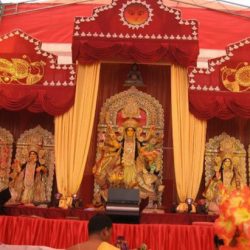13th Anniversary Sharodiyo Durga Utshob By BCS

Historically Bengal has a very rich cultural heritage. Bengal is, indeed, noted for its rich culture in songs, music, drama, dances and language. Its indigenous style of music, art, dance and drama is very rich. Bengali is one of the oldest languages in the world. According to statistics, jointly with Spanish, Bengali is the fourth largest language group in the world, only surpassed by Chinese, English and Hindi It is the first of Indian languages to develop western style secular fiction and drama. It originated from the Indo-Aryan family of languages in the 7th century, thus making it comparable to English, French and German. Bengali language is much older than Hindi, Urdu and even Portuguese, Spanish and many other established modern languages.
In the middle ages, Bengali was already a well-established language with popular poets like Bidyapati, Chandidas, Daulat Kazi and Alawol. It was during this period of middle ages that the famous Indian epics Ramayana and Mahabharata were translated in lyric forms from Sanskrit into Bengali by Krittibas and Kashiram Das respectively. This period also saw a rich output of romantic songs, poems and dance centering on the love of Radha and Krishna. These were simply superb in their wording, rhythm and style.
However, things started changing rapidly about 200 years ago. With the emergence of some great personalities like Iswar Chandra Vidyasagar (1820-91), Michael Madhusudan Datta (1824-73) and Bankim Chatterjee (1838-94) Bengali language and literature really got a new life. About one hundred and forty years ago came the famous Bengali poet Nobel Laureate Rabindranath Tagore (1861-1941) and then appeared rebel Poet Kazi Nazrul Islam (1899-1976). These two great Bengali poets have actually initiated a new era for Bengali language and culture. Tagore represented this new era of cultural modernization; others followed him almost as disciples. Palli Kabi Jasimuddin was also one of them. Tagore was urban, sophisticated and universal; Nazrul exhibited his spirit of protest and opposition to all social injustice, discrimination, oppression and exploitation while Jasimuddin vastly remained rural and provincial in his approach. Their common bond was their liberal outlook for secular Bengali culture.
Music, songs, drama and dances are also part of rich Benali culture and there are three mainstreams of this Bengali Culture: folk, modern and classical. Folk music mainly based is rural Bengal. It has been nurtured by the village singers, musicians, actors and dancers. With sweet melodies, touching words of love, tragedy and devotion, folk music is the most popular form of music in all over Bengal. The best known forms of folk music are bhatiali, baul, bhawaia, jaari, marfati and murshidi. Lalan Fakir, Hasan Raja, Nirmalendu Chowdhury, Abbasuddin Ahmed, Shachin Dev Burman, Purnadas Baul, Sadhan Bairagi and Abdul Halim are some of the greatest names in Bengali folk music.
On the other hand, the pioneers of modern Bengali music were, indeed, the world famous Nobel Laureate poet Rabindranath Tagore and the rebel poet Kazi Nazrul Islam. Tagore initiated a blend of East and West and Nazrul experimented with the synthesis of folk and Middle Eastern strains.
Bengal also shares the rich tradition of classical music of the subcontinent. Indeed, Bengal has produced many musicians and maestros of international repute like Ustad Alauddin Khan, Ustad Ali Akbar Khan, Pandit Ajoy Chakraborty and Pandit Ravi Shankar who have successfully made sitar and sarode popular all over the world.
Before I conclude let me describe a few words about the musical instruments which are also playing vital roles to promote the rich Bengali culture and its excellence. The typical Bengali folk musical instruments are Ektara (one string), Dotara (two, but actually four strings), Ghungur, Khol, Mandira, Behala (violin) and Banshi (flute) and the classical musical instruments are Sitar, Sarode, Tanpura, Sehnai, Eshraj, Pakhwaj, Tabla and Harmonium. Even now a large number of people in the villages of Bangladesh, West Bengal and Tripura regularly listen to the folk drama called Jatra and the age old melodic folk songs.
Bengali Performing Arts’ aim is to promote this rich Bengali cultural heritage and its excellence by organizing year-round quality cultural programmes and to make it more and more familiar which, I believe, help in enriching our multi-cultural society.
Pohela Boishakh is the first day of the Bengali Calendar. Pohela Boishakh is celebrated in a festive manner in both Bangladesh and West Bengal. In Bangladesh, Pohela Boishakh is a public holiday and in West Bengal it is a national holiday. It falls on April 14 or April 15 of the Gregorian calendar depending on the use of the new amended or the old Bengali Calendar respectively. In Bangladesh, it is celebrated on April 14 according to the official amended calendar designed by the Bangla Academy. Pohela Boishakh is also known as Nobo Borsho, (The Bengali New Year), as it is the first day of the first month of Boishakh in the Bonggabdo (Bengali Calendar). This day is a very festive time for Bengalis.
–
Uttom Kumar Nag
Honorary Secretary